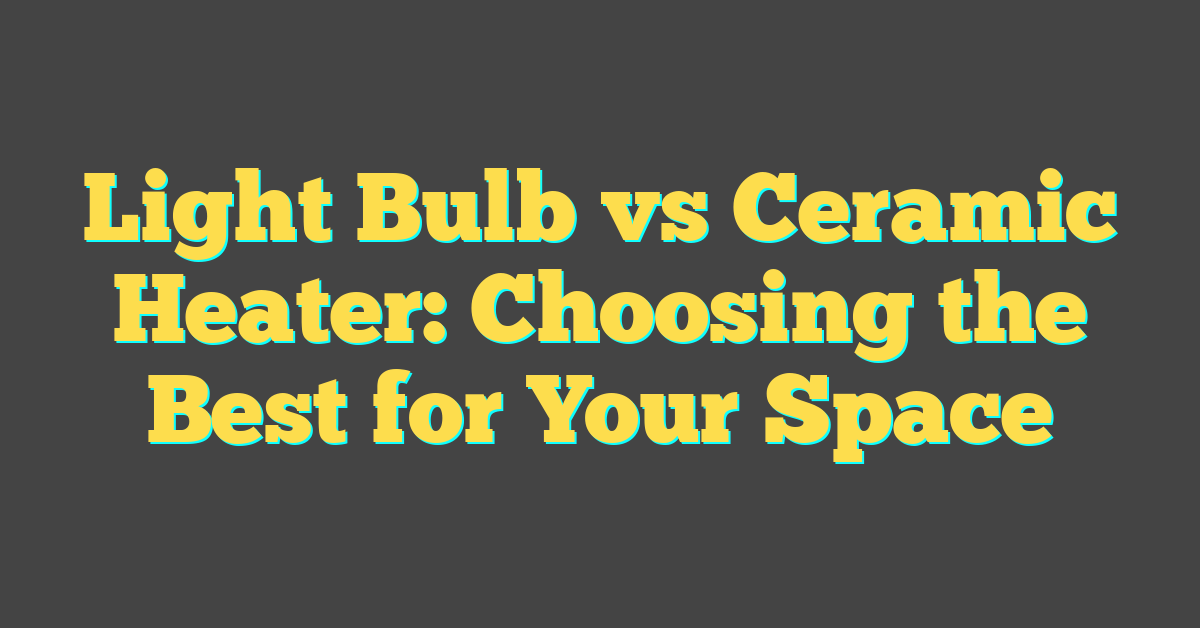When it comes to heating solutions, the choice between a light bulb and a ceramic heater can be pivotal depending on your specific needs. Light bulbs, although traditionally used for illumination, can also serve as a heat source. They generate both light and heat energy, making them a versatile tool in various settings. On the other hand, ceramic heaters are a type of electric heater that utilizes a ceramic heating element to produce heat. These heaters are designed to offer a more consistent and focused form of warmth without emitting light, making them a suitable choice for environments where constant light is undesirable.


Choosing the right type of heat source requires considering multiple factors such as energy efficiency, cost, and the specific application it’s needed for. While light bulbs are often less expensive and simpler to install, ceramic heaters can be more energy-efficient in the long run and provide a safer heating solution since they generally don’t get as hot to the touch. Additionally, for pet owners, particularly those with reptiles, the type of heat source is crucial, as it must cater to the animal’s biological needs for warmth without causing excess stress or hazards.
Key Takeaways
- Light bulbs offer versatile use but may not be as energy-efficient as ceramic heaters.
- Ceramic heaters provide consistent heat and are typically safer to touch, making them a reliable heating option.
- The choice between a light bulb and a ceramic heater depends on factors such as cost, longevity, and the specific heating requirements of your space or pets.
Understanding Light Bulbs and Ceramic Heaters
https://www.youtube.com/watch?v=vrMWHmPg0h8&embed=true
When choosing a heat source for your space, it’s important to understand the mechanics behind light bulbs and ceramic heaters. Your decision should be informed by how these devices use electricity to produce heat, their energy efficiency, and the type of heat they emit.
Basic Principles of Heating
Light bulbs, specifically designed for heating, like heat lamps, convert electrical energy into heat and visible light. They often use a filament that glows hot to provide warmth and illumination. The energy measured in watts reflects both their light output and heat generation. On the other hand, ceramic heat emitters produce heat through infrared radiation. These don’t emit visible light, making them a great choice if you need heat without light, such as for overnight animal care.
The amount of electricity consumed by both light bulbs and ceramic heaters directly correlates with their wattage. A higher-watt device will consume more electricity, and similarly, it will typically provide more heat.
Different Types of Light Bulbs
- Incandescent Bulbs: These are traditional, less efficient options that produce both light and heat but have a shorter lifespan.
- Halogen Bulbs: They tend to be slightly more energy-efficient and better at directing light and heat.
- Fluorescent Bulbs: These are primarily used for lighting and not as effective for heating purposes.
- LED Bulbs: Highly efficient for lighting, but produce minimal heat, not suitable as heat sources.
Heat lamps may vary in their design and efficiency but generally fall under the category of incandescent or halogen bulbs that emit enough heat to be useful in certain settings, like keeping chicks warm or providing focused warmth in a reptile’s enclosure. When a heat lamp is mentioned, it’s typically a higher-watt bulb, capable of generating more heat than a standard incandescent bulb used for room lighting.
Comparing Energy Efficiency

When you’re weighing the differences between light bulbs and ceramic heaters, it’s essential to consider how each one impacts your energy bill. Let’s break down what you need to know in terms of wattage and potential savings.
Measuring Wattage and Energy Costs
Your energy bill is largely dependent on the wattage of the devices you use. Light bulbs, including energy-efficient options, typically have a lower wattage compared to ceramic heaters. A standard incandescent bulb may use around 60 watts, while a comparable energy-efficient lighting option could use as little as 10 watts to produce the same light level.
On the other hand, ceramic heaters often range in wattage from 600 to 1,500 watts, indicating that they consume more energy. To calculate the energy costs, you’ll need to know your local utility’s cost per kilowatt-hour (kWh). Let’s assume an average cost of 12 cents per kWh:
- A 60-watt incandescent bulb running for 10 hours a day equates to 6 kWh/month.
- A 10-watt energy-efficient bulb for the same duration will be just 1 kWh/month.
- A 1,500-watt ceramic heater for 10 hours a day results in 450 kWh/month.
Energy-Efficient Benefits
Making the switch to energy-efficient lighting can reduce the wattage used by up to 85%. As a rule, energy-efficient bulbs, such as CFLs, convert more energy to light than to heat, which is why they’re cooler to the touch. Each CFL can save nearly 500 pounds of greenhouse gas emissions over its lifetime, which translates to noticeable savings on your energy bill.
Ceramic heaters, while more power-demanding, can still be part of an energy-conscious home. They quickly heat up and can be regulated with thermostats for efficiency. Remember, when you’re considering wattages and your energy costs, every amp and wattage counts. Your choices can lead to significant savings and a lighter environmental footprint.
Safety Considerations

« Alternatives to LED Light Bulbs: Exploring Different Lighting Options
Light Bulb Compared to Candle: Illuminating the Differences »
When comparing light bulbs and ceramic heaters, safety is a critical factor. Fire hazards and safe usage distance are two key aspects you’ll need to consider to ensure you’re using these devices safely.
Assessing Fire Hazards
Ceramic heaters require careful handling as they can be a fire hazard if not used properly. It’s vital to keep them away from flammable materials and ensure they are not at risk of tipping over. A helpful tip is to use ceramic heaters that have an automatic shut-off feature if they overheat or tip over, which significantly reduces the risk of fire.
Safe Usage Distance
While using a ceramic heater, maintain a safe distance between the heater and any objects. They should be placed at least 3 feet away from furniture, curtains, and other items. Light bulbs, particularly high-wattage bulbs, should also be kept away from direct contact with flammable materials to prevent overheating and potential fire risks.
Design and Functionality
https://www.youtube.com/watch?v=edBP810gJGY&embed=true
When choosing between a light bulb and a ceramic heater, it’s important to understand how each device is designed and how that relates to its functionality. They operate on different principles and are suited for various purposes based on their construction and heat emission methods.
Heating Elements in Ceramic Heaters
Ceramic heaters utilize a heating element made from positive temperature coefficient (PTC) ceramic material which, when electricity passes through it, generates radiant heat efficiently. Unlike traditional metal elements, this heating element doesn’t burn out quickly and also ensures your heater doesn’t get too hot to touch.
- Heat Distribution: Ceramic plates within the heater absorb the heat and radiate it into the surrounding area, providing even warmth.
- Safety & Longevity: The ceramic heating element has a self-regulating feature for improved safety and can last longer than traditional metal coils.
Light Bulb Operating Mechanism
An incandescent light bulb functions by sending an electrical current through a tungsten filament. The filament then heats up to a temperature that produces light and heat.
- Heat and Light Emission: The bulb emits both light and heat, but it is inefficient as most of the energy is converted to heat rather than light.
- Design Variants: You’ll find that some bulbs are designed to focus more on illumination while others, like infrared bulbs, are geared towards providing warmth.
Each of these products has a unique design tailored to its primary use—ceramic heaters for prolonged, efficient heating and light bulbs mainly for illumination with some heat as a byproduct. Understanding these mechanisms can guide you in selecting the right equipment for your needs.
Suitability for Pets and Reptiles
https://www.youtube.com/watch?v=Hxt_tmumKJg&embed=true
When it comes to keeping your pets comfortable and healthy, the choice between a light bulb and a ceramic heater is crucial. Both have their specific uses, depending on the type of pet, their heat needs, and your setup.
Maintaining Comfort for Reptiles
Your reptilian friends not only require warmth but also need a space that mimics their natural habitat. A ceramic heat emitter is excellent at creating an ambient heat covering a broad area of the enclosure, ensuring your reptiles can regulate their body temperature effectively. These heat emitters provide consistent heat without producing any light, making them suitable for day and night use.
In contrast, a heat lamp can create a regional basking spot that offers warmth and potentially UVB light, which is vital for some reptile species to synthesize vitamin D3. However, remember to consider the enclosure size and the specific comfort requirements of your pet. A larger enclosure might need a heat lamp to provide a concentrated area of warmth, ensuring your reptile can thermoregulate by moving between warmer and cooler areas.
Choosing the Right Heat Source for Chicks
Chicks require a warm environment to thrive, especially right after hatching. Their ability to maintain body temperature isn’t fully developed, so providing an external heat source is critical. For the early life stages of chicks, a heat lamp can be the preferred choice, as it simulates the warmth they would get from their mother.
A heat lamp for chicks can be easily adjusted to change the heat intensity, plus it allows you to observe your chicks clearly. Just be mindful to have a guard to protect your chicks from getting too close to the bulb. A ceramic heat bulb, on the other hand, could be beneficial as chicks grow and need less intensive care, delivering consistent and steady heat without the risk of disrupting their sleep cycles with light.
Remember, the key to using either a heat lamp or ceramic heater is to monitor the temperature regularly to ensure your pets’ utmost comfort and well-being.
Cost Analysis
https://www.youtube.com/watch?v=GBoRF19z78k&embed=true
When considering whether to purchase a light bulb or a ceramic heater, it’s important to weigh both the upfront investment and how much you’ll save over time. You also need to understand how efficiently each option can heat your space.
Initial Costs vs. Long-Term Savings
Initial Costs: Ceramic heaters generally have a higher purchase price compared to traditional light bulbs. However, when looking at energy-efficient models, you may find that investing in a ceramic heater could be more cost-effective in the long term due to lower energy consumption. For example, a 1500-watt ceramic space heater will cost approximately $0.18 per hour based on an energy cost of $0.12 per kWh, translating to about $2.16 for 8 hours of use, according to the Ceramic Heater Electricity Use Guide.
Long-Term Savings: While light bulbs are relatively inexpensive to purchase, they can be less efficient in terms of heating efficiency and, therefore, might lead to higher energy costs over time. The efficiency of a ceramic heater means that you could see a decrease in your energy bills, despite the higher upfront cost.
Effectiveness for Space Heating
Space Heating Efficiency: The wattage of a device directly influences its heating ability. While a high-wattage light bulb can generate a decent amount of heat, it cannot compare to a ceramic heater designed for space heating. A ceramic heater warms up a room more effectively by using convection technology, distributing heat throughout the space.
Energy Costs and Efficiency: It’s crucial to take into account the energy costs associated with running each device. Ceramic heaters are tailored for heating and thus are often more energy-efficient in maintaining room temperature. Since they can be controlled with thermostats and timers, you optimize your energy usage, which is less feasible with a standard light bulb.
Lifespan and Durability
When choosing between a light bulb and a ceramic heater, understanding their lifespan and durability can ensure that you make a cost-effective and long-lasting choice for your heating needs.

Comparing Lifespans
Ceramic Heaters: If you’re opting for a ceramic heater, you can anticipate a shorter lifespan in comparison to some electric heaters. On average, a ceramic heater may give you about 5,000 hours of functional use before efficiency starts to wane.
Light Bulbs: In contrast, standard incandescent light bulbs generally last around 1,000 to 2,000 hours. However, when used for heating, such as in heat lamps, their lifespan can be significantly shorter due to the continuous high operating temperatures.
Durability and Maintenance
Ceramic Heaters: Your ceramic heater’s durability is a strong point. Built to resist a good amount of wear and tear, they are quite robust. However, one consideration to keep in mind is their maintenance; ceramic heaters can sometimes be tricky to clean due to their design.
Light Bulbs: For durability, light bulbs fall short compared to ceramic heaters. They are more fragile and require careful handling. Maintenance wise, it’s simpler though, as replacing a bulb is generally easier than having to clean or repair a heater.
Remember, your choice will also impact energy efficiency. Ceramic heaters are often more energy-efficient for heating specific areas, meaning that, despite their shorter lifespan, they could save you power in the long run if used correctly.
Applications and Installations

When deciding between light bulbs and ceramic heaters, you’ll find that they cater to different needs in terms of warmth and illumination. Your choice impacts not only the ambient temperature but also how you’ll go about setting up the system.
Household and Commercial Uses
Light Bulbs:
- Ideal for areas where you wish to combine light and heat, such as basking areas for reptiles.
- Commonly used in living spaces for a cozy feel and in commercial settings where both illumination and warmth are desired.
- Wattage varies; higher watts mean more heat and light, but also increased energy consumption.
Ceramic Heaters:
- Provide a steady heat source without visible light, perfect for nocturnal animals or spaces needing consistent warmth.
- Often utilized in environments which require maintaining a specific temperature range without the disruption of light, like terrariums or some industrial applications.
Proper Installation Techniques
For Light Bulbs:
- Ensure compatibility of bulb wattage with your fixture to prevent overheating.
- Use a guard or shield to prevent direct contact with flammable materials.
For Ceramic Heaters:
- Must be installed in a proper ceramic socket due to high heat output.
- Suspended at a safe distance from objects and inhabitants to avoid burns or fire.
Installation Tips: Always follow manufacturer guidelines for both light bulbs and ceramic heaters to ensure safe and efficient operation.
Advantages and Disadvantages
When you’re deciding on a heat source for your space, it’s smart to compare the benefits and drawbacks of different types. Ceramic heaters offer cozy warmth and come with specific advantages, while light bulbs, often used in heat lamps, have their own set of considerations.

Pros of Ceramic Heaters
- Energy Efficiency: Ceramic heaters are generally energy-efficient; they heat up quickly and retain warmth, meaning your space gets warm without a long wait and without wasting energy.
- Safety Features: Many ceramic heaters are designed with safety in mind, including features like overheat protection to prevent them from reaching unsafe temperatures, which reduces the risk of accidents.
Cons of Light Bulbs
- Limited Heating: Light bulbs, such as those used in heat lamps, are better suited for spot heating. They’re not as effective for heating entire rooms, which might lead you to require multiple units, taking up more space and potentially increasing your electricity usage.
- Durability: Traditional light bulbs can burn out more frequently than the components of a ceramic heater, leading to a need for more frequent replacement and potentially higher long-term costs.
Alternative Heating Solutions
https://www.youtube.com/watch?v=uOi-D3WNyFM&embed=true
When exploring heating options beyond traditional light bulbs and ceramic heaters, consider efficiency, safety, and the type of heat they provide. This section will help guide your choice to ensure your comfort during colder seasons.
Exploring Other Heater Types
Oil-filled heaters are excellent for steady, long-term heating in your space. They operate silently as they warm up the oil inside, which then radiates heat into the room. The warmth from these heaters is long-lasting, even after the unit is turned off, due to the heat-retention properties of the oil.
Convection heaters work by warming the air around them. They’re typically faster at heating a room than oil-filled units since they circulate warm air upward, creating a cycle as the cooler air is pulled in to be heated.
Radiant heaters provide almost instant heat, directly warming objects and people in front of them rather than the air. This makes them ideal for spot heating when you only need a specific area warmed up quickly.
Considerations for Optimal Heating
When choosing a heater, it’s important to consider the type of heat you need. Convection heat works best to warm an entire room evenly and is usually quiet and efficient. This type of heat is often preferred for long-term comfort and complete room use.
If you’re using gas heaters, remember that they require proper ventilation to prevent the buildup of harmful gases in your home. This option is powerful and can heat larger spaces effectively, but safety precautions such as installing carbon monoxide detectors are a must.
For those who prefer fuel heaters, such as kerosene, these can be very effective but also require ventilation and carry the risk of fuel odors. Fuel heaters are transportable, which gives you flexibility in heating different areas as needed.
When using any type of heater, always be sure to follow safety guidelines and the manufacturer’s instructions to avoid any hazards. Proper maintenance will not only ensure your safety but also the longevity and efficiency of your chosen heating solution.




